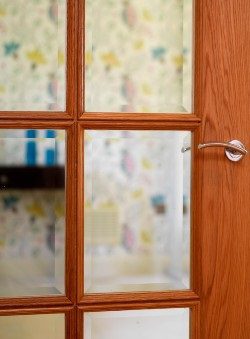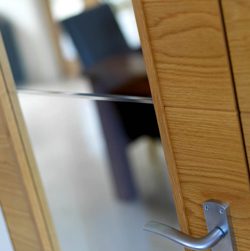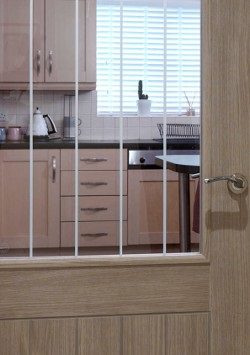The Different Types of Glass Used in Glazed Internal Doors
Clear or etched; stained, bevelled … there is nothing quite as stunning as glass. Versatile and beautiful, glazed internal doors come in a whole range of different designs, using an array of fascinating techniques to achieve the perfect look for your home.
So what is a bevelled edge? How does it differ from a diamond cut? When you’re browsing through door designs to get the look you want, it can be very useful to have a working knowledge of different terms so you know the options out there.
Here are some of the design styles in the market, including many we have at JB Kind, to help you narrow down your ideal internal glazed door.
Clear glass – the options
If you particularly want sunshine to flow through your interior space, a clear glass door will really help maximise that light. But clear doesn’t have to be boring. There are lots of sophisticated details that give your door that all-important design flair.

Bevelling – these are doors where the edges of the glass slope down, as in this image. It’s a subtle touch for an elevated look.
Diamond cut – This is a technique where grooves are cut into the glass. Simple but classy, it helps provide a visually interesting, but unfussy look.
Etching – These are doors where a pattern is etched on to the glass. There are some absolutely stunning historical examples of this technique which you can sometimes see in the windows of Victorian-era pubs. To make etched glass, the manufacturer will mask off areas that are not to be changed, before acid is poured on to create this stunning look. An etched door can provide a gorgeous visual appeal to give a sense of design flair to your home.

Sandblasting – This is a similar idea to etched glass and is used to create a frosted appearance in certain areas. The manufacturing process involves masking off areas and then blasting others with an airgun that shoots out sand. This wears away at the surface to create the desired effect.
Obscure, or ‘Frosted’ glass – These types of glass have varying degrees of opacity. The frosting process results in glass that provides a degree of privacy. It can be very successfully used in bathrooms and hallways where light is needed. The most popular styles are made by Pilkington, with glass like this usually formed through a mould.
Fire glass
This is the most important type of glass from a safety perspective. Both the glass in a fire door and the door itself must be fitted strictly in accordance with its fire certification.
However, it is also good to know that to comply with safety regulations, fire glass does not have to be the wired glass often seen in commercial or public premises. More options are now available – good to know!

Stained glass
Famously seen in churches across the world, stained glass is simply stunning. This ancient technique involves adding metallic salts to create different colours. Although stained glass was for centuries mainly seen in religious buildings, you can often spot it in residential properties now, particularly in panels above a front door where it can help provide a gorgeous colourful entrance to a home.
Leaded glass
Leaded glass is a way of breaking glass up into patterns by dividing them with pieces of lead. Often associated with period-style front doors from the Victorian and Edwardian era, it can be stunningly effective. Whether you choose a diamond style effect or a range of squares and rectangles, leaded doors really add the ‘wow’ factor to your home.
Bullet proof glass
Also known as ‘ballistic’ glass, this type of glass is often used in buildings which need protection. The technique involves laminated glass layers. The more layers there are, the greater the protection.
Whichever type of glass type you go for in your glazed door, you’re certain to find bags of choice here at JB Kind! Our team of experts are always available on the phone to answer your questions.